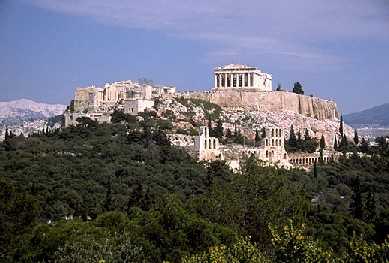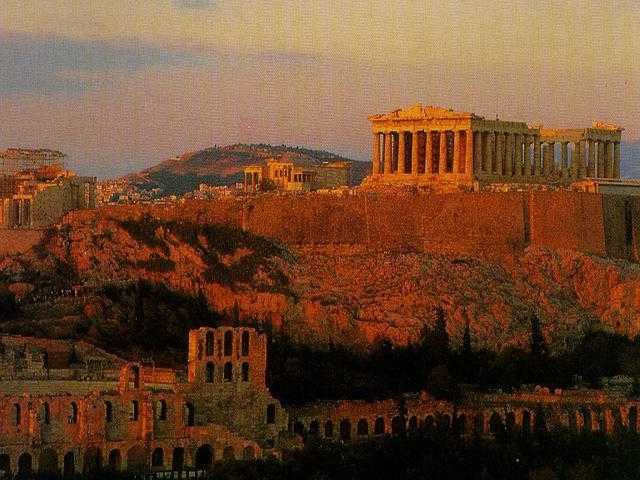

Travelling to Athens.


1) Acropolis, the simble of Athens. It's one of the most important landmarks in world history. The Parthenon, the main monument on the site, was built in favour of goddess Athena, the patron of the city 2) Sunset in Athens.
We suggest you a 5-day travel to the
capital of Greece - Athens and several exursions to nearby sightseeings. See
the map of Greece.
Greece is a heaven for connoisseurs, experts and amateurs of Arts. How
many unique priceless old relicts and monuments are here!
With well over a hundred inhabited islands and a territory that stretches from
the south Aegean to the Balkan countries, Greece offers enough to fill months
of travel. The historic sites span four millennia, encompassing both the legendary
and the obscure, where a visit can still seem like a personal discovery.
First day - a 5-hour excursion will show
you Acropolis, Agora and Plaka. See
the maps of Athens.
The starting point of the excursion - Monastiraki (see map location number
25). The name of this square is connected with little Byzantinean church
of Pantanassa and the word "Monastiraki" means "monastery".
The Greek Agora (37), the central square, is situated near Monastiraki. More than 2000 years ago traders sold fruits and fish, orators gathered crowds of listeners here. Come here early in the morning when there are few people here and try to be carried away in the past at the colonnade, where in the 2-d century BC workshops and offices were. Now there is a museum here with the finds from the excavations on Agora. (Agora and the museum: Mon. 12.00-1900, Tues.- Sun. 8.00-19.00, tel. (30)210-3210185) At the other side of this long colonnade towers Thisseio, the antic templ devoted to the Greec god of fire Gefest. Thisseio, the most well preservedantic temple, was built in 450 BC.
Not far from the Greec Agora there is the Roman Agora (26). The Tower of Winds (27) stands here with its relief frieze and allegoric image of seven winds.
High above the archaic Agora Acropolis (1) is. Propileas, the
ceremonial entrance to the Acropolis, were built in 437-432 BC. Situating
on the right of the Propileas, the Temple of Nica is a refined specimen
of architecture of Ionic order. Scenes of fights between Athenians and Percian
horsemens and gods helping the fighters are depicted on the frize of the temple.
The Parthenon and the Erecthion are two famous temples dated from
the 5-th century BC. The perfection of their proporcions and contours astonishes.
If you want to seethe originals of porticos from the Erecthion and the original
of frieze from the Temple of Nica, visit the Museum of Acropolis. (Mon.
12.00-1900, Tues.- Sun. 8.00-19.00, tel. (30)210-3214172, ticket 12 euro)
Two antic theaters are seen from the top of Acropolis. One of
them is Odeon. See
the pictures. In summer evenings spectators,
having made themselves comfortable on the modern seats watch the perfomanses
on the Roman stage of the 2-d century. (You can
buy tickets in the box-office at Stadiou, 4, tel. (30)210-3221459).
The destroyed Theatre of Dionysous (3) is the oldest in Europe.
Plaka, the old city of Athens, is below the Acropolis and more or less
between Monastiraki and Syntagma. On the way to the Placa you'll see the memorial
to Lisicrat. It's enjoyable to walk, discover small exhibits on the way through
and small museums such as the Museum of Children's Art (29), The Museum
of Greek Folk Art (30), Museum of Musical Instruments.
Second day - The centre of the modern city is at Syntagma Square (12) (Constitution Square), site of the former Royal Palace, the Greek Parliament and other 19th century public buildings. Most of the older and wealthier parts of the city and clustered around this area, which is also where most of the tourist attractions and museums are.
Psirri.North of Monastiraki
you'll find old warehouse buildings, mid-age office and industrial buildings
presenting a new face. This is the area of intriguing restaurants in novel settings
with original interior and exterior design, benefiting from the character and
nature of the original use of these industrial buildings. Art galleries and
artists' workshops and studios, neighbour Experimental Theatres and cafe/bars.
Find what you like here by wandering around during the day and return for the
prize pickings (the places you choose to dine in and have a drink at) later
that night.
National Gardens. Behind
and to the south of the Parliament building , bordered by Amalias Street, are
these extensive gardens - housing the Zappeion Exhibition hall (9) and providing
semi shaded walking, away from traffic, amongst trees and shrubs.
Lykavittos. Bit of a steep
walk uphill to the viewing area and church of Agios Georgios (57),
rewarded by excellent views. The Lykavittos theatre (59) is actively
used for performances. There is a restaurant (price category A/B) and a cafe
at the top.
On the way to Lykavittos, at Dexameni (beyond Kolonaki square), there is a Summer
Cinema - movies shown in the open air, worth a try if it's a new experience
for you. There is also a summer cinema in Plaka square: Cine Paris. It
has wonderful plants and a view of the Acropolis, competing with the movie for
your attention.
Kolonaki. Boutique clothing stores, pricier antiques, furs, jewelry and kiosks which sell a better cigar and great selection of foreign press, magazines and newspapers!
Third day - the excursion to the city Delphi. It's better to spend here the whole day: in the morning you can look at the excavations, at the day to visit the museum and in the evening to have a rest in a on the Square Hrisso. The main attractions in Delphi are the Temple of Apollon and the Sanctuaries of Apollon and Afina. The local museum is one of the richest museums of Greece. The pride of this museum is the bronze statue of a coach-man (474 BC). The details, such as eyes of coloured stones delicate eyelashes and lips are maid with a unsurpassed skill. See the pictures.
In
the evening - the return to Athens.
Fourth day - the
excursion to the town Metheora.
Metheora
is the place where the sky and the ground are
contiguous.
It's known by its dready stalagmite rocks and by cloisres situated in them.
You can visit Agios Stefanos, Angia Triada, Megalo
Metheora. See
the pictures.
In
the evening - the return to Athens.
Fifth day - You can visit some of numerous
islands. Egina with its countryside landscapes is the real salvation
for those who are tired from the fuss of Athens and Delphi. One of the most
famous temples of Greece is situated here. Andros, the most northern
of Kikladian islands have two best museums of the country in its main city,
Chora: the Archaeological Museum and the Museum of Modern Art.
The ideal time for tourism in Greece is May - June. At this time the nature is already in bloom and people can swim. In July - August in the South and Central Greece thermometer shows 45°.
Required documents for getting
visa:
Before you go, it's a good idea to make photocopies of all important documents and keep them in a separate place from the originals.
Traveler's Health.
See your doctor at least 4-6 weeks before your trip to allow time for shots
to take effect. The following vaccines may be recommended for your travel to
Western Europe. (Hepatitis A, hepatitis B As needed, booster doses for tetanus-diphtheria).
Discuss your travel plans and personal health with a health-care provider to
determine which vaccines you will need. Required Vaccinations - none. Disease
Risks: Leishmaniasis.
Accommodation.. Omiros Hotel - average price -27 $, User Rating: 3.3333333333333 stars

See other photos of the hotel.
Restaurants. The restaurant Symposium, offers you dishes of Greek cuisine, dances at the evening and music - from 30 euro.Plaka, Mnissikleous, 24b. Gerofinicakas - dishes by old Constantinople's receipts - from 15 to 30 euro. Not far from Kolonaki, Pindarou, 10.
The public transport system
in Athens consists of bus, metro, tram and suburban railway services. See
the map of the Athens’s transport.
Shopping
The first area you will normally be recommended to shop in is Ermou street,
the pedestrian street that runs off Syntagma at McDonald's. Yes there are
some good shops here for clothes, but veer off into the side streets for cloth
and varied items and also try Monastiraki. If you will be going to Pireas
and are looking for lower priced items, you'll probably do better there.
(Opening hours are: 8.30-13.30 & 17.30-20.30 Tuesday,
Thursday, Friday. Monday and Wednesday 8.30-14.00. Saturday 8.30-14.30 (or 15.00),
Sundays closed. Some department stores are open everyday from 8.30 to 20.30
without a break (except Saturday; they also close at 15.00). Tourist and other
shops in tourist areas may be open for more hours and on Sundays.)
It is not very likely that you will find any ancient Greek relics on sale -
but if you did, their export is illegal anyway.
Worth a visit is also the six-storey, colourful and buzzing bookstore "Eleftheroudakis"
on Panepistimiou (between Syntagma and Omonia) (48). You can find an enormous
variety of books, a lot of them in english or other languages, fantastic books
about art and travel, wonderful maps and more.
Expenses :
Total - 839 $
+
Greec tour-operator - Golden Eagles, Moscow - (095) 9166787,
Greece - (30) 24670-25137. http://www.golden-eagles.ru - the site in Russin
language. You can book tickets, the rooms in a hotel and so on.